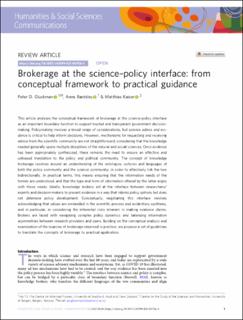| dc.contributor.author | Gluckman, Peter D. | |
| dc.contributor.author | Bardsley, Anne | |
| dc.contributor.author | Kaiser, Matthias | |
| dc.date.accessioned | 2022-02-03T14:03:36Z | |
| dc.date.available | 2022-02-03T14:03:36Z | |
| dc.date.created | 2021-05-18T12:52:34Z | |
| dc.date.issued | 2021 | |
| dc.identifier.issn | 2662-9992 | |
| dc.identifier.uri | https://hdl.handle.net/11250/2976950 | |
| dc.description.abstract | This article analyses the conceptual framework of brokerage at the science–policy interface as an important boundary function to support trusted and transparent government decision-making. Policymaking involves a broad range of considerations, but science advice and evidence is critical to help inform decisions. However, mechanisms for requesting and receiving advice from the scientific community are not straightforward, considering that the knowledge needed generally spans multiple disciplines of the natural and social sciences. Once evidence has been appropriately synthesized, there remains the need to ensure an effective and unbiased translation to the policy and political community. The concept of knowledge brokerage revolves around an understanding of the ontologies, cultures and languages of both the policy community and the science community, in order to effectively link the two bidirectionally. In practical terms, this means ensuring that the information needs of the former are understood, and that the type and form of information offered by the latter aligns with those needs. Ideally, knowledge brokers act at the interface between researchers/experts and decision-makers to present evidence in a way that informs policy options but does not determine policy development. Conceptually, negotiating this interface involves acknowledging that values are embedded in the scientific process and evidentiary synthesis, and in particular, in considering the inferential risks inherent in making evidence claims. Brokers are faced with navigating complex policy dynamics and balancing information asymmetries between research providers and users. Building on the conceptual analysis and examination of the nuances of brokerage observed in practice, we propose a set of guidelines to translate the concepts of brokerage to practical application. | en_US |
| dc.language.iso | eng | en_US |
| dc.publisher | Springer Nature | en_US |
| dc.rights | Navngivelse 4.0 Internasjonal | * |
| dc.rights.uri | http://creativecommons.org/licenses/by/4.0/deed.no | * |
| dc.title | Brokerage at the science–policy interface: from conceptual framework to practical guidance | en_US |
| dc.type | Journal article | en_US |
| dc.type | Peer reviewed | en_US |
| dc.description.version | publishedVersion | en_US |
| dc.rights.holder | Copyright The Author(s) 2021 | en_US |
| dc.source.articlenumber | 84 | en_US |
| cristin.ispublished | true | |
| cristin.fulltext | original | |
| cristin.qualitycode | 1 | |
| dc.identifier.doi | 10.1057/s41599-021-00756-3 | |
| dc.identifier.cristin | 1910499 | |
| dc.source.journal | Humanities & Social Sciences Communications | en_US |
| dc.identifier.citation | Humanities & Social Sciences Communications. 2021, 8, 84. | en_US |
| dc.source.volume | 8 | en_US |

